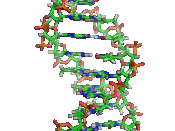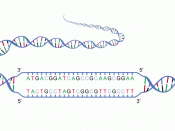IntroductionIn this day and age there is a high demand for products that are increasingly smaller. Electronics manufacturers across the world are constantly in a race to make a new, smaller product to satisfy medical, scientific, and personal technological needs. Experts predict this will be forced to a halt around the year 2010. When electronic components become so small that current manufacturing methods no longer suffice, DNA may be used to assemble them.
This report assesses the current problem of computer technology and miniaturization reaching its limits in correlation with its alternative biological solution. It will encompass the evolution of computers and their components, the cause of the problem at hand, the solution to the problem, and the current progress of the solution. Nanolithography, the present-day method of constructing circuits, will become obsolete and the DNA assembling process will replace it.
By estimated 2010, there is going to be no further progress in how we are currently miniaturizing computer components.
Scientists have come up with the next step which could completely change technology as we know it. The alternative is using biology to make parts many times smaller, and about a thousand times faster.
Computer EvolutionThe first computers were activated chiefly by large, vacuum tubes: archaic versions of transistors. These tubes were ineffective due to their unreliability and tendency to overheat. The transistor, invented in 1947 at Bell Telephone Laboratories, rapidly succeeded the vacuum tubes. Transistors make up an integrated circuit which is then used to create a complete circuit. Just as the transistor replaced the vacuum tube, DNA self-assembly will soon replace the transistors.
ProblemWhile the 5-10 nanometer circuitry using DNA is preferable to the currently used nanolithographic process which can only generate features as small as 65 nanometers (a nanometer is a billionth of a meter) wide, this...


